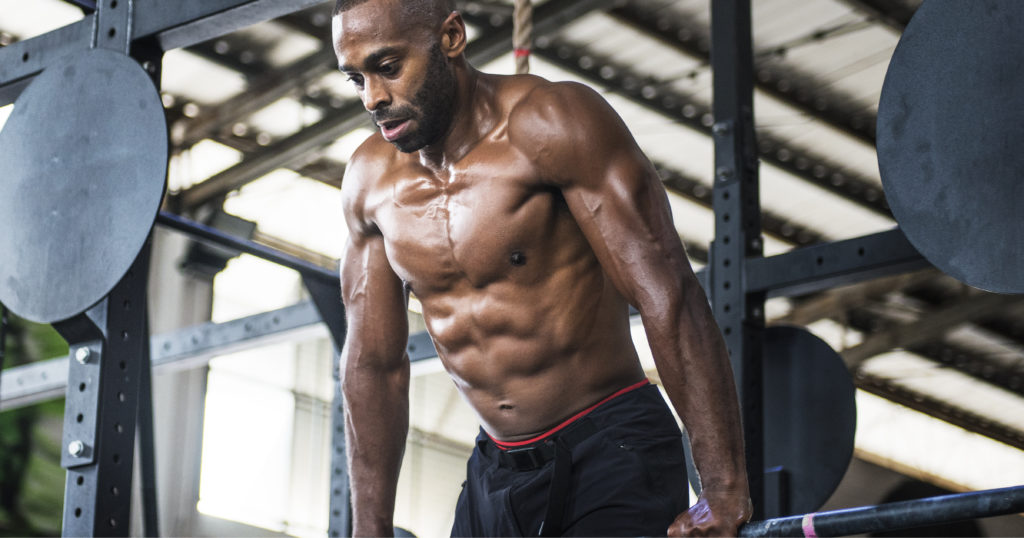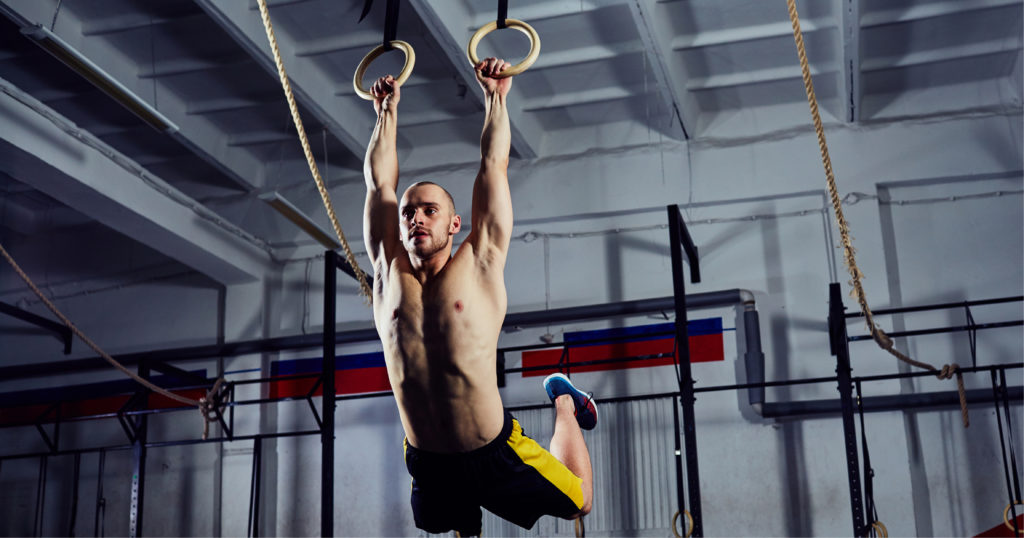The muscle-up is an advanced bodyweight movement that requires upper body strength, total body coordination, and midline stability. Many fitness goers and competitive fitness athletes alike seek to master the muscle-up and it’s variations to improve performing in competitive WODs, competitions, and/or to simply build out their fitness toolbox.
In this article we will go through everything you need to know about the muscle-up, including:
- Muscle-Up Form and Technique
- Benefits of the Muscle-Up
- Muscles Worked by the Muscle-Up
- Who Should Do the Muscle-Up
- Muscle-Up Sets, Reps, and Programming Recommendations
- Muscle-Up Variations and Alternatives
How to Perform the Muscle-Up: Step-By-Step Guide
Below is a step-by-step guide on how to perform the muscle-up. Note, that this is the instructions to perform a bar muscle-up using a kip. If you were to perform these on rings, the mechanics would be fairly similar.
Step 1. Set Up
Hang from a pull-up bar with the hands slightly wider than shoulder width. Take a false grip (thumbs not wrapped over the bar). Practice hanging in the hollow hold position, then start to kip. Using a kipping motion will help to establish momentum while maintaining midline stability.
Coach’s Tip: Keep the legs together and glutes contracted at all times.
Step 2. Chest to Bar
Perform a chest to bar pull-up, aggressively kipping yourself upwards towards the bar. Be sure to keep your body rigid and legs together. Aim to pull the lower chest/stomach to the bar by leaning back as you pull yourself upwards.
Step 3. Roll Over the Bar
Once you have your chest up and over the bar, throw your chest and shoulders forwards over the bar so that you assume a straight bar dip bottom position. Again, keep your body rigid and midline controlled.
Coach’s Tip: Using a false grip will help you during this turnover/transition phase.
Step 4. Press Yourself Up
To finish the muscle up, perform either a strict or kipping straight bar dip, fully extending the elbows at the top and establishing control. Again, keep your body rigid and midline controlled.
Step 5. Repeat
To perform multiple muscle ups in consecutive order, you can simply drop down and restart the kipping movement or perform more cyclical muscle ups. This does require more advanced training and skill development. To do this, push yourself backwards off the bar, returning into the kipping cycle and performing your next repetition.
Benefits of the Muscle-Up
The muscle up is a highly specific movement for gymnastics and competitive fitness/CrossFit training. Due to its highly sport specific benefits, it lacks the overall general benefits of muscle growth and fitness for most general fitness and sports athletes. The risk-to-reward for performing this movement can be limited by the amount of skill, strength, and mobility necessary to perform it correctly; which may also be why some many individuals want to learn it.
If you are wanting to learn the muscle-up outside of sport specific purposes, you must determine if your goals of muscle building, fat loss, strength, and power can be better served by other forms of fitness. That said, the muscle-up can offer total body fitness, develop grip and arm strength, and improve competitive fitness performance and skill.

Muscles Worked: Muscle-Up
The muscle-up is a total body movement that heavily relies on momentum to perform the movement. The muscle building effects of the muscle-up are limited due to the lack of time under tension and usage of momentum. If a lifter wanted to increase the hypertrophic effect of the muscle up, less ballistic variations such as the strict muscle up is recommended.
- Back (Latissimus Dorsi)
- Biceps and Forearms
- Chest
- Triceps
- Core (Rectus Abdominals, Obliques)
- Glutes and Posterior Chain
Who Should Perform Muscle-Ups?
Below are a few groups of athletes that can benefit from including the muscle up within their training programs.
Strength, Power, and Sport Athletes
The muscle up is a skill-based movement that is often used in gymnastics and functional/competitive fitness and CrossFit training. Formal strength and power athletes will often find little benefit from performing this highly skilled and movement specific exercise.
Strength and power athletes who want to perform the muscle up should determine the risk of injury, the time it takes to train the movement, and overall strength and power benefits (little to none) are worth the investment.
https://www.instagram.com/p/BxNrc_HgF2U/
Competitive CrossFit and Fitness Athletes
The muscle-up is a sport-specific movement that CrossFit and competitive fitness athletes must be able to perform. For this reason, mastering the muscle up-and its variations can be helpful in improving overall performance during WODs and competitions.
Muscle-Up Sets, Reps, and Weight Recommendations
Below are two (2) primary sets, reps, and weight (intensity) recommendations for coaches and athletes to properly program the muscle up.
Skill Acquisition
The muscle-up is a complicated movement that requires high levels of skill, mobility, and positional awareness and strength. Often, when teaching this exercise the individual steps are trained, and then put back together again. To train for increased skill and technique, deconstructing the movement is recommended; however coaches and athletes can still perform the full movement using temporal, pauuses, and assists. It is recommended that repetitions are kept low to avoid fatigue.
- Multiple sets of 1-3 repetitions, never reaching muscular fatigue
- Integrating pauses, strict variations, and deconstructing the muscle up into its individual parts often works to help improve technique and address faults.
Muscle Endurance
The muscle up can be trained for muscle endurance (as well as strength, however this is less common). Higher repetitions can be used, assuming skill and strength is established. Often, this is necessary for competitive fitness enthusiasts and athletes.
- Multiple sets of moderate (3-10) repetitions
- Note, there is no magical repetition range to perform these, as this exercise is highly dependent on skill, strength, and ability levels. High-level athletes will perform longer repetition sets and shorter repetition sets, both successfully achieving muscle endurance and competition success. Ultimately, it is up to the individual athlete to recognize their abilities.

3 Muscle-Up Variations
Below are three (3) muscle-up variations to increase core stability, muscle endurance, and midline control.
1. Strict Muscle-Up
The strict muscle up can be done with a bar or rings, and is often a more advanced variations that can be used to increase strength, shoulder stability, and positional coordination. This exercise is highly challenging on the upper body.
2. Ring Muscle-Up
The ring muscle up is done on gymnastic rings similar to the bar. When using rings, the athlete/lifter must establish greater midline and shoulder joint stability, and body control. This does allow for slightly greater individual modifications regarding wrist positioning and movement, as the lifter can manipulate the ring positioning more than the fixed bar.
3. Band Assisted Muscle-Up
The band assisted muscle up is a variation that can be used to regress a standard bar or ring muscle up. This can be done to help beginner lifters slow down the muscle up movement, develop necessary strength and coordination, and address individual skills needed during positions of the muscle up.
2 Muscle-Up Alternatives
Below are three (3) muscle up alternatives that can be used to improve core stability and strength.
1. Weighted Pull Up + Dip
This is a great alternative to mix into training to develop the necessary upper body strength and positional awareness needed for the muscle up. Combining strict and/or kipping pull ups with dips works the muscles of the back, chest, and arms in the direct manner as muscle ups.
2. Chest-to-Bar Pull-Ups
The chest-to-bar pull-up is a highly specific movement for functional fitness athletes. This movement is great for improving a foundation for connecting muscle-ups, and is slightly less taxing for the full body.
More Bodyweight and Gymnastics Training Articles
Here are a few more articles you can read to develop a stronger core, improve body weight strength and endurance, and improve gymnastic skills.
Feature image from baranq / Shutterstock